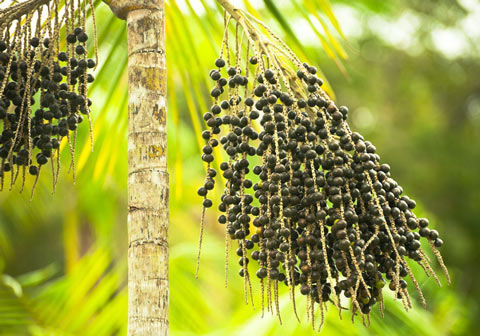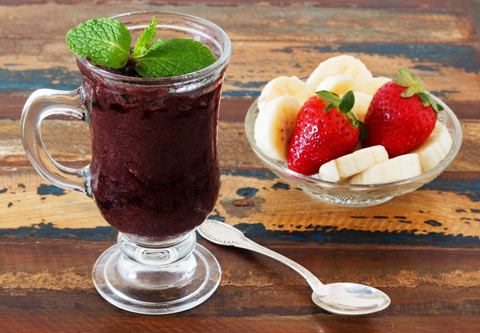Açaí – Anticancer Palm Berries from the Amazon

Did You Know?
The bulk of each grape-sized açaí fruit is a single seed. But that doesn't mean it gets thrown away! (i.421)
Açaí seeds are great for animal feed. Even when rotten, pulverized açaí seeds make for rich potting soil. Research shows that açaí seeds can even be gasified and used for fuel. (i.421, 424)
The açaí berries of the Euterpe oleracea palm tree are known as açaí fruit around the world. There are two commonly known varieties of açaí, which produce different colors of grape-sized fruit: (i.421, 422)
- Açaí preto produces a dark purple fruit.
- Açaí branco, a type that produces greenish yellow fruit and creamy juice.
The pulp of açaí fruit is mostly used as a drink, but there are also industrial uses for açaí. Popular commercial food products include: (i.422-424)
- Ice cream
- Pastries
- Popsicles
- Smoothies
- Soda
However, parts of this palm tree are traditionally used in native folk medicine to treat a variety of conditions. Modern research has confirmed that açaí, açaí extract, açaí seeds, and açaí oil have anti-inflammatory and antioxidant effects — including cancer fighting benefits. (i.421, 425-426)
Cancer-Fighting Compounds in Açaí
Açaí berries have a much higher antioxidant potential than many other fruits, with an ORAC value of almost 103,000. (i.427)
Açaí extracts reduce free radicals, prevent DNA damage, and block the growth of various types of cancer, including:
- Bladder cancer (i.428)
- Brain cancer (i.429)
- Breast cancer (different types) (i.429, 430)
- Colon cancer (i.425)
- Kidney cancer (i.431)
- Liver cancer (i.431)
- Leukemia (i.432)
- Melanoma (i.433)
Research shows açaí reduces the following types of proteins and enzymes that promote cancer cell growth and metastasis: (i.425)
- Adhesion molecules
- Growth factors
- Inflammatory transcription factors
- Proteins that help cancer cells survive
At the same time, açaí promotes enzymes that help get rid of cancer cells. (i.425)
The pulp and skin from açaí fruit contains many cancer-fighting compounds, including:
Other beneficial compounds in açaí include:

- Alpha and beta-carotene (i.431)
- 19 different amino acids (i.434)
- Benzoic acid (i.431)
- Calcium (i.434)
- Catechin (i.431)
- Gallic acid (i.431)
- Lutein (i.431)
- Polyunsaturated fatty acids (such as linoleic acid) (i.434)
- Scoparin (i.434)
- Vanillic acid (i.455)
- Velutin (i.505)
- Xylan (i.506)
Açaí fruit also contains a substantial amount of dietary fiber. (i.434)
Additional Potential Health Benefits of Açaí
Research suggests açaí and açaí extracts may have benefits in various conditions and chronic diseases.
These include:
- Acute and chronic pain (i.507)
- Alzheimer's disease (i.508)
- Atherosclerosis (i.509)
- Cognitive decline (i.510)
- Diabetes (i.511)
- Emphysema (i.512)
- Endometriosis (i.513)
- Fatty liver disease (i.514)
- Heart attack (i.515)
- Hypertension (i.516)
- Kidney failure (i.517)
- Listeria food poisoning (i.518)
- Memory loss (i.510)
- Metabolic syndrome (i.511)
- Negative effects of cigarette smoking (i.519)
- Obesity (i.511)
- Osteoporosis (i.520)
- Skin aging (i.521)
- Unhealthy cholesterol levels (i.522)
- Wound healing (i.523)
Açaí may even help in various food production applications. For example:
- Açaí helps probiotic bacteria survive in ice cream. (i.524)
- As a food preservative, açaí could help prevent food poisoning in minimally processed foods. (i.518)
- Açaí edible films for food have antibacterial and antifungal effects. (i.423)
- As a food coloring, açaí juice adds antioxidants to yogurt. (i.525)
- Sugar-free candies made with açaí are so good taste-testers prefer them to those made with sugar! (i.526)
Are There Any Safety Concerns with Taking Açaí Supplements?
Açaí and açaí oil are generally considered safe. Açaí berries are an edible fruit loaded with beneficial nutrients — including minerals, polyunsaturated fatty acids, amino acids, and flavonoids. Açaí oil is traditionally used for its medicinal properties. Clinically, açaí has been tested as a safe and effective contrast dye for MRI studies. (i.434, 455, 527)
One of the minerals açaí has ample amounts of is manganese. In fact, some studies show that açaí contains levels of manganese that are higher than recommended. (i.474)
Manganese is an essential mineral. However, at very high levels manganese can be toxic to brain cells by promoting damaging free radicals. (i.474)
So what's the bottom line? At typical dietary levels, açaí has beneficial antioxidant effects. But high-concentration supplements may be pro-oxidant. Conversely, studies show that açaí extract actually protects brain cells from oxidative free radical stress caused by manganese. Experts suggest more studies are needed to determine safe supplementary levels of açaí. (i.474, 528)




